The Navio® Surgical System
The NavioSurgical System is changing the way surgeons performpartial knee replacement. Navio utilizes image-free principles, meaning the patient does not have to schedule a pre-operative CT scan. Instead, the surgeon uses advanced tools to map the patient’s anatomy and kinematics (movement)during the procedure. 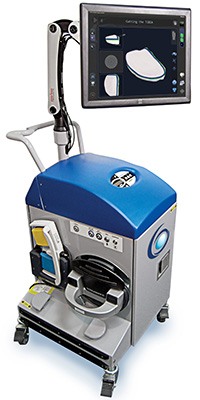 This allows the surgeon to create a plan tailored specifically for the patient. To aid the surgeon in accurate implant placement, a robotic-assisted handheld instrument is used toperform the procedure according thesurgeon defined plan.
This allows the surgeon to create a plan tailored specifically for the patient. To aid the surgeon in accurate implant placement, a robotic-assisted handheld instrument is used toperform the procedure according thesurgeon defined plan.
Navio’s touchscreen monitor and linear workflow are designed leveragethe surgeon’s strengths with the system’s advanced tools. The reproducible accuracy of Navio allows the surgeon to offer partial knee replacement to early- to-mid stage osteoarthritis sufferers who might otherwiseonly be offered total knee replacement. Partial knee replacement, while traditionally a difficult surgery to perform with consistency, can lead to excellent intermediary outcomes for younger, osteoarthritis sufferers when done well1. Therefore, a surgeon who is more confident in offering partial knee replacement to their patients can utilize a procedure that when compared with total knee replacement may offer:
- Less pain2
- Quicker rehabilitation and recovery3,4
- Lower risk of complications3
- Smaller incisions4
- Shorter hospital stay5
Beyond the potential benefits of a partial knee replacement over a total knee replacement, the Navio system provides:
- Consistent results6
- Accurately placed implants6
- Customized planning
- No CT radiation required
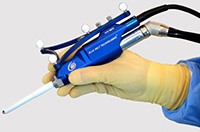 With Navio for partial knee resurfacing, there is no special preparation or post-operative recovery protocol. During the surgery, the surgeon will use advanced image-free navigation steps to create a virtual reconstruction of anatomy, soft-tissue/ligaments and kinematic motion of the knee. The surgeon uses this information to tailor the position of the implant to the patient’s femur and tibia shape, taking into account the patients unique cartilage wear and condylar shapes, and then balances their soft-tissue ligaments. Finally, the surgeon uses the Navio handpiece to sculpt the damaged bone away to accept the artificial joint. The robotic-assisted handpiece enforces the target surgical plan, making sure that the final placement of the implant is accurately placed according to the intended position.
With Navio for partial knee resurfacing, there is no special preparation or post-operative recovery protocol. During the surgery, the surgeon will use advanced image-free navigation steps to create a virtual reconstruction of anatomy, soft-tissue/ligaments and kinematic motion of the knee. The surgeon uses this information to tailor the position of the implant to the patient’s femur and tibia shape, taking into account the patients unique cartilage wear and condylar shapes, and then balances their soft-tissue ligaments. Finally, the surgeon uses the Navio handpiece to sculpt the damaged bone away to accept the artificial joint. The robotic-assisted handpiece enforces the target surgical plan, making sure that the final placement of the implant is accurately placed according to the intended position.
References
- Borus T, Thornhill T. Unicompartmental knee arthroplasty. J Am Acad Orthop Surg. 2008;16(1):9-18.
- Hall et al., “Unicompartmental Knee Arthroplasty (Alias Uni-Knee): An Overview with Nursing Implications,” Orthopaedic Nursing, 2004; 23(3): 163-171
- Brown, NM, et al., “Total Knee Arthroplasty has Higher Postoperative Morbidity than Unicompartmental Knee Arthroplasty: A Multicenter Analysis,” The Journal of Arthroplasty, 2012.
- Repicci, JA, et al., “Minimally invasive surgical technique for unicondylar knee arthroplasty,” J South Orthopedic Association, 1999 Spring; 8(1): 20-7.
- Bolognesi M, et al. Unicompartmental Knee Arthroplasty and Total Knee Arthroplasty Among Medicare Beneficiaries, 2000 to 2009. J Bone Joint Surg Am. 2013 Nov;95:e174(1-9).
- Lonner, Jess, et al. “High Degree of Accuracy of a Novel Image-free Handheld Robot for Unicondylar Knee Arthroplasty in a Cadaveric Study.” Clin Orthop Relat Res, DOI 10.1007/s 1999-014-3764-x
Navio Surgery – Questions and Answers
Q: What is partial knee replacement/resurfacing?
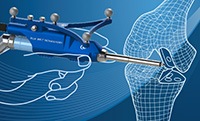 Partial Knee Replacement, or Partial Knee Resurfacing, or Partial Knee Arthroplasty represents a surgical procedure which replaces diseased (OA) bone with artificial surfaces. The surgical procedure occurs through a smaller or minimally invasive incision, and can treat either the medial, the lateral (inside or outside) compartment of the knee. Additionally, the patellofemoral joint (PFJ) (beneath the patella/knee cap) can be singularly resurfaced if damaged or more commonly in conjunction with the medial compartment. A PFJ and medial PKR combination surgery is referred to as bi-compartmental (two compartments of the knee) knee replacement. During PKR, the surgeon not only replaces the damaged joint, but re-balances the knee’s alignment. If a patient is several degrees out of neutral mechanical leg alignment, the PKR procedure can correct to near neutral – fixing bow-legged or knock-kneed deformities.
Partial Knee Replacement, or Partial Knee Resurfacing, or Partial Knee Arthroplasty represents a surgical procedure which replaces diseased (OA) bone with artificial surfaces. The surgical procedure occurs through a smaller or minimally invasive incision, and can treat either the medial, the lateral (inside or outside) compartment of the knee. Additionally, the patellofemoral joint (PFJ) (beneath the patella/knee cap) can be singularly resurfaced if damaged or more commonly in conjunction with the medial compartment. A PFJ and medial PKR combination surgery is referred to as bi-compartmental (two compartments of the knee) knee replacement. During PKR, the surgeon not only replaces the damaged joint, but re-balances the knee’s alignment. If a patient is several degrees out of neutral mechanical leg alignment, the PKR procedure can correct to near neutral – fixing bow-legged or knock-kneed deformities.
Q: Why would I choose partial knee replacement over total knee replacement?
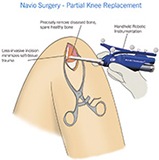 Partial Knee Replacement has certain potential benefits over a Total Knee Replacement procedure for those patients who are properly indicated for PKR1. Whereas TKR completely reconstructs the knee and often sacrifices both the ACL and PCL, a partial knee procedure preserves any functioning and healthy ligaments and only replaces the compartment(s) of the knee that have osteoarthritic damage. This means that the patient may recover quicker from PKR surgery than TKR because of the smaller incisions and limited disruption to the soft-tissue capsular structure2.
Partial Knee Replacement has certain potential benefits over a Total Knee Replacement procedure for those patients who are properly indicated for PKR1. Whereas TKR completely reconstructs the knee and often sacrifices both the ACL and PCL, a partial knee procedure preserves any functioning and healthy ligaments and only replaces the compartment(s) of the knee that have osteoarthritic damage. This means that the patient may recover quicker from PKR surgery than TKR because of the smaller incisions and limited disruption to the soft-tissue capsular structure2.
Q: What are the results of partial knee replacement?
A well-done partial knee replacement in an appropriately selected patient can have the survival rate that is comparable to that achieved with a total knee replacement in the first decade following surgery. The literature suggests that after the second decade, the revision rate may be somewhat higher for partial knee surgery than for total knee surgery. There may be an advantage to prolonging function and reducing pain in the patient’s joint prior to a total knee replacement, which is an end-of-the-line option2.
Q: Why does the Navio system work well for PKR?
The Navio system works well for PKR because it allows the surgeon to utilize advanced robotic-assisted technology for accurate bone cutting in a platform that does not require a pre-operative CT scan. The robotic-controlled handpiece puts the power of a robotic-arm into the surgeon’s hands for them to engage fully with the operational technique.
References
- Brown, NM, et al., “Total Knee Arthroplasty has Higher Postoperative Morbidity than Unicompartmental Knee Arthroplasty: A Multicenter Analysis,” The Journal of Arthroplasty, 2012.
- Borus T, Thornhill T. Unicompartmental knee arthroplasty. J Am Acad Orthop Surg. 2008;16(1):9-18.
Navio Knee Replacement Surgery
The Navio system provides robotic assistance in partial knee replacement, aiding in precise surgical outcomes for patients living with knee pain caused by early to mid-stage osteoarthritis. A Navio procedure differs from other robotic-assisted surgery because it allows for handheld instrumentation to assist the surgeon in bone resurfacing.
How Can Navio Help
 Navio surgery aids the surgeon in partial knee replacementthat can result in a return to daily activity and decrease in pain. During the procedure, the diseased portion of the bone will be replaced with an implant that spares healthy bone and returns function.
Navio surgery aids the surgeon in partial knee replacementthat can result in a return to daily activity and decrease in pain. During the procedure, the diseased portion of the bone will be replaced with an implant that spares healthy bone and returns function.
Partial knee replacement may offer several benefits over total knee replacement:
- Less pain1
- Quicker rehabilitation1,2
- Smaller incisions3
- Preserves ACL and PCL
- Less bone loss
What can Navio mean for you?
- Accurately placed implants
- No CT radiation required
- Customized planning for your knee
What is osteoarthritis?
Millions of Americans suffer from the debilitating pain of osteoarthritis (OA) each day. As one of the leading causes for disability worldwide, OA is a degenerative joint disease resulting in the wearing and eventual loss of cartilage. Those suffering from OA often experience quality of life issues, loss of mobility, stiffness and swelling and joint pain activated by activity.
How does a Navio surgery work?
The surgeon uses advanced image-free navigation to create a virtual reconstruction of the patient’s knee anatomy, ligament tension, and kinematic motion. This information is used to tailor the position of the implant to the patient’s femur and tibia shape, taking into account the patient’s unique cartilage wear, condylar shape, and soft-tissue balance. The surgeon then uses Navio’s robotic-assisted handpiece to sculpt damaged bone away from remaining healthy bone. The handpiece enforces bone resection within the surgeon defined plan, ensuring final placement of the implant is accurately positioned as intended.
Learn More
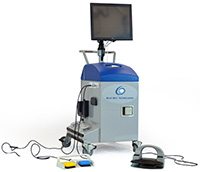 Call (760) 835-7317 for a consultation.
Call (760) 835-7317 for a consultation.
For more information on the Navio system visit www.bluebelttech.com
- Hall et al., “Unicompartmental Knee Arthroplasty (Alias Uni-Knee): An Overview With Nursing Implications,” Orthopaedic Nursing, 2004; 23(3): 163-171.
- Brown, NM, et al., “Total Knee Arthroplasty Has Higher Postoperative Morbidity Than Unicompartmental Knee Arthroplasty: A Multicenter Analysis,” The J. of Arthroplasty, 2012.
- Repicci, JA, et al., “Minimally invasive surgical technique for unicondylar knee arthroplasty,” J South Orthopedic Association, 1999 Spring; 8(1): 20-7
![]() Navio Surgery Background Overview
Navio Surgery Background Overview
![]() Navio Orthopedic Surgical System
Navio Orthopedic Surgical System
You will need the Adobe Reader to view and print these documents. ![]()
